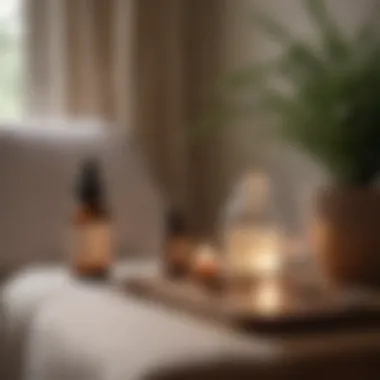Guided Meditation Techniques for Better Sleep


Intro
In today’s fast-paced world, many individuals struggle with obtaining restorative sleep. Sleep deprivation can lead to several health issues, including decreased cognitive function and emotional instability. Guided meditation has emerged as a viable tool to combat these challenges. By employing guided meditation techniques, individuals can relax their minds and bodies, paving the way for healthier sleep patterns.
This article examines the mechanics of guided meditation, highlighting its significant role in enhancing sleep. Readers will gain insights into various forms of meditation practices, their benefits, and practical tips for beginners. By incorporating these techniques into nightly routines, one can potentially transform their sleep experience.
Understanding Guided Meditation for Sleep
Guided meditation serves as a significant tool for those seeking improved sleep quality. It intertwines mental processes and relaxation techniques to alleviate sleep disturbances. The relevance of this practice in the context of sleep cannot be overstated. By fostering both relaxation and focus, guided meditation generates a mental state conducive to sleep. It effectively engages the mind, directing attention away from daily worries, making it easier to slip into a restful slumber.
What is Guided Meditation?
Guided meditation involves listening to a narration that steers the mind towards relaxation and tranquility. This form of meditation typically includes a combination of instructions, calming music, and ambient sounds. The guidance may focus on specific themes or techniques aimed at promoting relaxation, such as visual imagery or mindfulness exercises. Practitioners often find comfort in the presence of a guide, who provides reassurance and structure to the meditation experience. This process can help diminish anxiety and encourage a peaceful state of mind, crucial for falling asleep.
The Science of Sleep and Meditation
Understanding the connection between sleep and meditation is essential. Numerous studies highlight that meditation can physically alter brainwaves. This shift induces relaxation and reduces stress hormones, which are often responsible for insomnia. During sleep, our bodies strive to repair and rejuvenate, making quality sleep vital for mental and physical health. Guided meditation taps into this need, preparing the body by fostering deep relaxation. This synergy between meditation and sleep is supported by scientific findings that suggest regular practice can enhance overall sleep quality and duration.
How Guided Meditation Affects Sleep Patterns
Research indicates that guided meditation can positively impact sleep patterns. Individuals who engage in this practice often report falling asleep more quickly and experiencing enhanced sleep quality. The techniques involved help in regulating the body's natural rhythms. They encourage deeper sleep stages and are linked to less restlessness throughout the night. Furthermore, guided meditation can assist in reshaping sleep habits, aiding individuals who struggle with sleep disorders. Over time, consistent participation in guided meditation can lead to more stable and restorative sleep patterns.
Types of Guided Meditations for Sleep
The practice of guided meditation holds significant value for those seeking improved sleep quality. Each type of guided meditation available serves distinct purposes and brings forth particular benefits that can enhance a person's ability to fall asleep and stay asleep. By understanding the various types, one can better choose a method that resonates most effectively with their needs and preferences.
Body Scan Meditation
Body Scan Meditation is a technique that involves focused attention on different parts of the body. This method requires practitioners to visualize each body region, noticing sensations and tensions without judgment.
It helps promote relaxation by encouraging the individual to release and let go of tension in a systematic manner. By focusing deeply on physical sensations, the mind can shift away from daily worries and distractions, making it easier to drift into peaceful sleep. Additionally, many people find this method effective for connecting mind and body, enhancing their ability to relax at bedtime.
This practice can be particularly beneficial for those who carry stress in their bodies, as it teaches awareness and encourages physical relaxation. It can be easily incorporated into one's nighttime routine as a short session before sleeping.
Visualization Techniques
Visualization Techniques involve creating mental images that evoke feelings of calm and serenity. This method can vary widely, but generally, a practitioner imagines peaceful landscapes, restful environments, or tranquil scenarios.
By engaging the imagination, there is a strong diversion from daily stresses and anxiety. Visualization enhances relaxation by providing the mind a particular focus which reduces restlessness. Practicing these techniques can help develop a mental toolkit for achieving calm, thus providing tools for not only bedtime but also throughout daily life. It's important to create vivid, positive mental visuals to enhance effectiveness in helping one settle down.


Breath Awareness Practices
Breath Awareness Practices focus primarily on tuning into the natural rhythm of one's breathing. This technique emphasizes inhaling and exhaling in a controlled manner. It promotes mindfulness and can significantly reduce anxiety levels.
Focusing on each breath pattern encourages slowing down and helps create a peaceful transition into sleep. The practice promotes a sense of stability and connects one deeply with their body. It is also adaptable to different styles. For instance, one can choose to practice shallow or deep breathing based on personal comfort. This flexibility makes it an appealing option for many individuals.
Progressive Muscle Relaxation
Progressive Muscle Relaxation (PMR) is a method that involves sequentially tensing and relaxing specific muscle groups. It is a systematic approach that encourages the participant to focus on the contrast of tension and relaxation.
This technique effectively reduces physical tension accumulated during the day. PMR takes less time to learn and practice, making it an excellent addition to anyone's sleep routine. Some find it particularly effective for falling asleep quickly as it promotes bodily awareness and reduces physical discomfort.
In summary, each of these guided meditation types serves a unique function, but all share the same goal: to create a tranquil pathway to sleep. By exploring the nuances of Body Scan Meditation, Visualization Techniques, Breath Awareness Practices, and Progressive Muscle Relaxation, individuals can select a method aligned with their personal preferences, enhancing their overall sleep experience.
Setting the Stage for Sleep
Establishing a proper environment for sleep is crucial for reaping the benefits of guided meditation. A conducive setting not only enhances the effectiveness of meditation techniques but also significantly influences overall sleep quality. Envrionment acts as a backdrop that can maximize relaxation and minimize disturbances. This section explores various elements that can help set the stage for restful slumber.
Creating a Conducive Sleep Environment
A conducive sleep environment must address several factors such as bedding, temperature, and personal comfort. First, consider the quality of your mattress and pillows. These elements play a vital role in physical comfort, which can either facilitate or hinder relaxation during meditation.
- Factors to consider include:
- Comfort of Bedding: Invest in a good mattress and pillows that support your sleeping posture. Memory foam or adjustable pillows can enhance neck support.
- Room Temperature: The ideal room temperature for sleep is usually between 60 to 67 degrees Fahrenheit. Too hot or too cold can disrupt your ability to relax fully.
- Noise Control: Use soft fabrics, carpets, or soundproofing materials to minimize noise. White noise machines can also help mask external sounds that may disturb your meditation.
By addressing these factors, you create a space where your body can relax, and your mind can find peace.
Silencing Distractions
Distractions in your environment can severely impact your ability to meditate and sleep well. Identifying and eliminating these disruptors is essential for achieving deep, restorative sleep. Here are some considerations:
- Digital Devices: The blue light emitted from screens can interfere with sleep. Try to keep electronic devices out of the bedroom. If this is not possible, use blue light filters or night modes.
- Organized Space: A clutter-free space can alleviate stress. Declutter your room and remove items that may cause distraction. A clean room can contribute to a clean mental space.
- Ambient Sound: Consider using headphones or earplugs if you live in a noisy area. Alternatively, soothing nature sounds can assist in masking disruptive noises.
Silencing distractions helps create an atmosphere of tranquility, essential for effective guided meditation and quality sleep.
The Role of Light and Darkness
Light has a significant influence on our sleep-wake cycles, making it vital to manage lighting effectively. Understanding how light affects sleep can guide you in creating an optimal environment:
- Light Exposure During Day: Natural light exposure during the day promotes a healthy circadian rhythm. However, you should be cautious about artificial light in the evening.
- Darkness for Sleep: A dark room signals your body that it is time to sleep. Blackout curtains can significantly block outside light. Additionally, consider dimming lights as bedtime approaches to prepare your mind for sleep.
- Avoid Bright Lights: If you need to wake during the night, try using low-light sources rather than bright overhead lights, which can disturb your sleep cycle further.


Practical Tips for Effective Guided Meditation
Guided meditation can significantly influence sleep quality, providing a pathway for relaxation and mental clarity. However, to maximize its impact, practical tips are essential. These tips are designed to aid individuals in navigating their meditation experience, helping them to find the right approach that resonates with their needs. Understanding these elements is crucial for anyone looking to enhance their rest through guided sessions.
Choosing the Right Guided Sessions
Selecting the appropriate guided meditation session is integral to achieving relaxation. There are various styles to choose from, depending on personal preferences and specific sleep issues. Some popular options include narrations focused on deep breathing, calming imagery, or body scans. Each technique has a unique approach to inducing relaxation, and it might take experimentation to determine what works best. It's also helpful to consider the duration of sessions. For beginners, shorter sessions might be more manageable, while those experienced in meditation may prefer longer formats.
When choosing a session, pay attention to the voice of the guide. A soothing and calming voice can make a significant difference in relaxation. Moreover, consider the background sounds included in the session. Ambient sounds or soft music can enhance the meditation experience but make sure they do not become distracting.
Using Technology to Aid Meditation
Technology can offer valuable resources for guided meditation. Mobile apps like Calm, Headspace, or Insight Timer are specifically designed to provide structured sessions aimed at improving sleep. They allow users to choose sessions based on length and focus area. Furthermore, these apps often include various techniques catering to different stages of sleep, which can support deeper rest.
Another practical use of technology is setting reminders or alarms for meditation sessions. Regular practice is key. By scheduling meditation in your daily routine, you create a disciplined approach towards better sleep.
Smart devices such as smart speakers can also play guided meditation tracks. Voice-activated instructions can provide hands-free options, making it easier to access sessions without disrupting a calming environment.
Incorporating Meditation into a Sleep Routine
Integrating guided meditation into a sleep routine involves creating consistent habits. A nightly ritual can signal the body that it's time to wind down. Start by setting a specific time each night dedicated to meditation. This can help establish a soothing pre-sleep ritual that enhances relaxation.
Begin with calming activities preceding meditation, such as gentle stretching or reading. These routines help transition the mind and body into a more relaxed state, facilitating a smoother shift to meditation. Additionally, creating a serene environment can reinforce the habit. Ensure that the space is quiet, comfortable, and dark to promote a sense of security.
Once meditation becomes a part of your routine, you may notice an improvement not only in sleep quality but in overall mental well-being. This shift can lead to a significant reduction in pre-sleep anxiety, allowing for a deeper and more restorative slumber.
"Meditation is not about trying to throw ourselves away and become something better. It’s about being who we are already." - Pema Chödrön
Through strategic selection of sessions, the use of technology, and establishing a routine, guided meditation can effectively enhance sleep quality.
Common Challenges and Solutions
Guided meditation for sleep is a powerful tool, yet many people encounter challenges when trying to practice it. These challenges can discourage individuals, leading to frustration and a potential abandon of the practice. Addressing these difficulties is vital to improving the effectiveness of guided meditation sessions. This section will explore common obstacles and provide practical solutions, making the journey toward restful sleep more attainable.
Difficulty in Concentration
Concentration can often be elusive, particularly in moments intended for relaxation. Many individuals find it hard to focus on the guidance offered during a meditation session. This difficulty can stem from various distractions, whether internal or external. It's important to acknowledge that this struggle is common. Practitioners should not feel disheartened by it. Here are some effective strategies:
- Shorter Sessions: Start with shorter guided meditations. Five to ten minutes may be easier than a full 30-minute session. As comfort builds, gradually increase the time.
- Environment Control: Ensure that the environment is calming. Dim lighting and comfortable seating can promote concentration.
- Mindfulness Techniques: Employ mindfulness practices to gently guide thoughts back to the present. When distractions occur, addressing them without judgment can help maintain focus.
Managing Racing Thoughts


Another prevalent issue is racing thoughts. This mental activity can become more pronounced when attempting to quiet the mind. An overactive mind often hinders relaxation. It is crucial to understand that meditation is not about stopping all thought but rather observing them without attachment. To manage racing thoughts effectively:
- Acknowledge Thoughts: Accept that thoughts will arise. Acknowledge them without sinking into them.
- Focused Breathing: Concentrating on controlled breathing can ground the mind. Taking deep, slow breaths offers a point of focus, diverting attention from chaotic thoughts.
- Visualization: Use visualization techniques as a tool to replace racing thoughts. Imagining a peaceful scene can help create mental space.
Overcoming the Fear of Not Sleeping
The fear of not being able to fall asleep can become a barrier to relaxation. This anxiety can trigger more stress and make it harder to drift off. Acknowledging this fear as a natural response is the first step. There are approaches to counteract these apprehensions:
- Preparation: Establish a routine. Knowing what to expect from the meditation process can reduce anxiety.
- Positive Affirmations: Incorporate affirmations that affirm the ability to relax. Repeating calming phrases can instill a sense of security.
- Diversified Techniques: Experiment with different forms of guided meditation. For instance, consider listening to mindfulness recordings, soothing musicians like Calm, or audio specifically tailored for sleep.
Ultimately, recognizing and addressing these challenges can pave the way for more effective guided meditations. By understanding personal obstacles and implementing practical solutions, enriched sleep experiences can lead to better overall mental health.
Evaluating the Impact of Guided Meditation on Sleep Quality
Understanding the impact of guided meditation on sleep quality is crucial for anyone seeking improved nightly rest. Guided meditation can include various techniques that may enhance an individual's ability to fall asleep and maintain restful slumber. This section will delve into the essential elements associated with measuring sleep outcomes and personal experiences to highlight the overall effectiveness and significance of these practices.
Measuring Sleep Outcomes
An array of methods exists to assess the impact of guided meditation on sleep. These might include sleep diaries, questionnaires, and objective measurements via sleep tracking devices or polysomnography. Each of these tools can provide valuable insights into how meditation influences sleep patterns.
- Sleep Diaries: Individuals keep daily logs of their sleep duration, quality, and disturbances. This self-reported data can highlight trends over time associated with meditation practices.
- Questionnaires: Instruments like the Pittsburgh Sleep Quality Index can help gauge general sleep quality before and after implementing meditation techniques.
- Sleep Tracking Devices: Wearable devices and apps that monitor sleep cycles and movements can offer real-time data. This objective metric can complement subjective reports in understanding changes in sleep quality.
Regular assessment through one or a combination of these methods can afford individuals a better grasp of how guided meditation may contribute to their sleep.
Personal Reflections and Experiences
Personal reflections on guided meditation and sleep can vary widely from one individual to another. These subjective experiences often provide qualitative insights that quantitative measures might overlook. Many practitioners report profound changes in their sleep after consistent meditation.
Some common reflections include:
- Increased Relaxation: Many individuals express feelings of profound relaxation post-meditation, noting how it prepares their mind and body for sleep.
- Consistent Sleep Improvement: Users frequently mention a pattern of improved sleep over time, volunteering personal anecdotes of how meditation helped reduce insomnia.
- Mindfulness Awareness: Increased awareness of thoughts and feelings through meditation can aid individuals in recognizing pressing issues that may disrupt sleep, thereby encouraging better coping mechanisms.
"Since I started using guided meditation, I feel more in control of my anxiety, which previously kept me awake. The change has been noticeable."
The End
Guided meditation serves as a powerful tool for those seeking to enhance their sleep quality. This article highlights significant elements, such as the relationship between meditation and sleep, different meditation techniques, and the benefits of establishing a conducive sleep environment.
Through understanding the psychological mechanisms that underpin meditation, one can appreciate how these practices can reduce anxiety, calm the mind, and ultimately lead to improved sleep. Applying techniques like body scan meditation or breath awareness can specifically target areas that hinder restful sleep. Furthermore, the discussion on creating a supportive environment logically relates to the practice, as it promotes a state of tranquility necessary for effective meditation.
The Future of Meditation and Sleep Practices
The evolution of meditation practices continues to unfold, particularly in the realm of sleep. With advancements in technology and a growing body of research, future approaches may incorporate more interactive or personalized guided sessions. Smart sleep devices might integrate meditation techniques to tailor experiences based on individual sleep patterns. Such innovations could make meditation more accessible and effective for wider audiences. Therapists and wellness coaches may also leverage guided meditation as a staple in treatment programs for sleep disorders, establishing it as an essential technique in sleep management.
Encouragement for Continued Exploration
Delving further into guided meditation can lead to a richer understanding of its benefits. Readers are encouraged to keep experimenting with various techniques and to integrate them into their nightly routines. Consider reaching out to communities or platforms such as Reddit to share experiences or gain insights from others who have ventured into guided meditation. The journey of exploring meditation is personal; discover what works best for you. As awareness continues to grow, individuals can help establish guided meditation as a crucial part of promoting mental well-being and securing restorative sleep.







